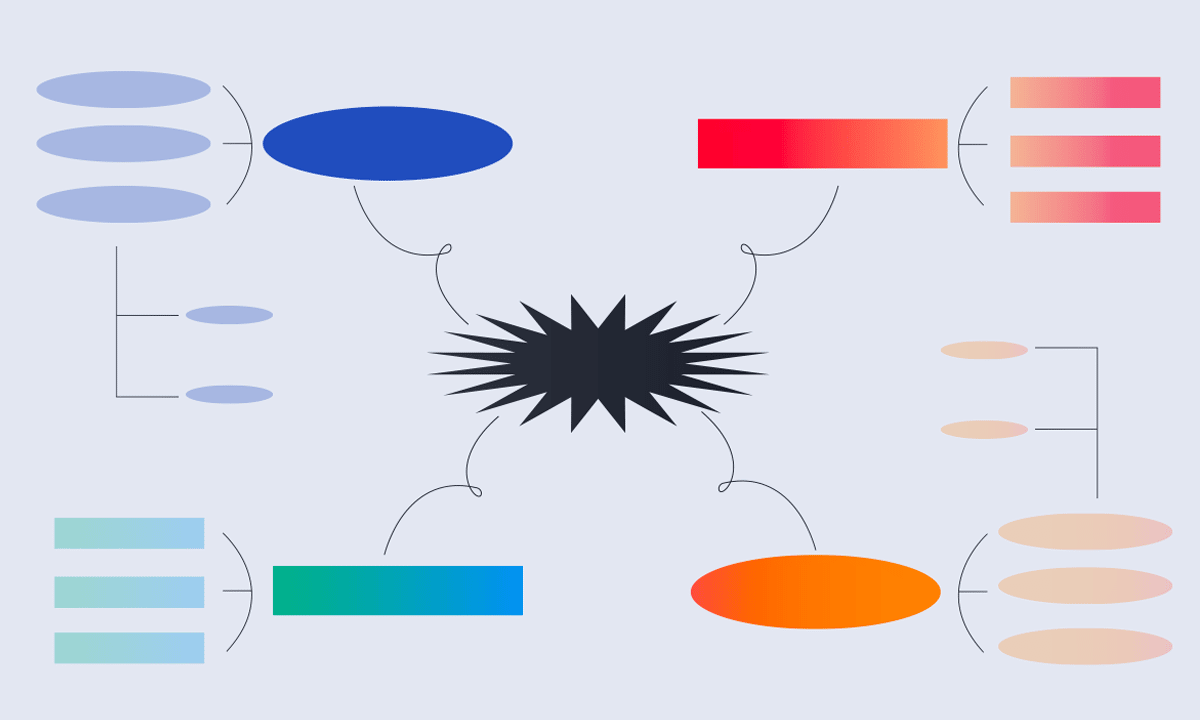Have a ton of organizational knowledge floating around the office these days? No matter your role, it can be difficult to make sense of all the knowledge your company has accumulated over time without a visual aid, without a diagram. Knowledge maps help organizations make sense of this information and identify gaps in content or subject matter expertise.
This guide will help you create a knowledge map that’s both informative and visually appealing.
We’ll cover what knowledge maps are, how you can create your own, how to choose knowledge mapping software, and what role knowledge maps play in a company’s knowledge management strategy overall.
What is a knowledge map?
A knowledge map is a graphical representation of a particular domain of knowledge and the relationships between concepts or pieces of information under this domain.
Knowledge maps can help you and your team:
- Understand concepts
- Find information quickly
- Learn new information
- Visualize different concepts and organize information.
Here are just a few ways different organizations use knowledge maps.
- Business: Business owners can use knowledge maps to create new products or services, enter new markets, and solve problems.
- Education: Teachers and students can use knowledge maps to organize and display information, memorize concepts, and prepare for exams.
- Healthcare: Doctors, nurses, and other healthcare professionals can use knowledge maps to keep track of medical information, find new treatments, and communicate with colleagues.
- Government: Government agencies can monitor trends, plan policies, and investigate issues with knowledge maps.
- Nonprofit: Nonprofits can leverage knowledge maps to track data, measure their impact, and tell stories.
Types of knowledge maps
Three common knowledge maps are mind maps, concept maps, and issue maps. Organizations often use process maps and issue maps to make decisions and ensure people, processes, and technology align. These three types of knowledge maps as described by Jack Park, an author and computer science expert on knowledge mapping technologies, can help any organization improve its collective brain trust.
Before you create your knowledge map, below are a few different kinds of knowledge maps to consider.
Mind maps
Mind maps represent the lowest level of mapping information; think brainstorming, linking related concepts.
Concept maps
Concept maps
made of nodes and arcs, define the relationship between two or more related concepts. For example, energy that can exist in the form of lightning would be a node and arc as part of a knowledge map.
Dialogue and issue maps
These maps use decision points, different possibilities, and branching structures to help map out possibilities.
Decision trees
In knowledge management, enterprises commonly use decision trees as a way to map out long, complex process documents as a series of easily digestible steps to follow. They visually represent all options in a situation and the possible outcomes of each option.
Decision trees are a preferred content type for many customer support teams because it takes the guesswork out of complex processes. Agents obviously prefer step-by-step instructions that change based on input…rather than long articles.
Cause and effect diagrams
A cause and effect diagram is a knowledge map that can help you find the possible root causes of an event or problem. They’re commonly used in product planning to avoid quality issues.
Site maps
As a typical web development tool, site maps improve website navigation. They can also map out the structure of any document, such as an eBook.
Task flows
A task flow shows the steps it takes to complete a specific activity. Corporate settings often use task flows to document processes or create standard operating procedures.
Activity diagrams
Business owners and project managers use activity diagrams to map business processes. These diagrams show sequences of activities that you can use to optimize efficiency and find bottlenecks in your operations.
Steps to create a knowledge map
The best way to understand a knowledge map is to create one! You can start your knowledge map manually on a whiteboard, but be sure to use knowledge mapping software to share with others and gather feedback.
Once you identify what type of knowledge map best represents knowledge you will be sharing, here is a simple process to follow.
Step 1
Determine what you want to map out; gather information
The first step is to decide what you want to map out. Determine the goals or process you hope to accomplish with your knowledge map. Many companies use a knowledge map to identify where company knowledge lives, who created it, and what kind of gaps exist.
Once you’ve decided on a topic or direction, gather all relevant information. You can do this by researching, interviewing experts, or collecting data to input into your knowledge map.
Step 2
Identify key concepts
Once you’ve chosen a topic, identify the key concepts related to that topic. These will be the building blocks of your knowledge map.
To identify the key concepts, can ask yourself questions like:
- What are the most important ideas?
- What are the main categories you need or want to analyze?
- What are the most pressing topics to pay attention to?
To provide direction and structure, you may want to define your key concepts before the knowledge-gathering process. But you can always adjust the concepts as you learn more about the topic.
Step 3
Map out relationships between concepts
Once you have the scope of what you want to map, identify the relationships between your key concepts using lines, decision points, or even color coded sections if helpful.
Try to understand the similarities and differences between connected concepts. Identify causal relationships using dotted lines and consider any dependencies. Include the key concepts as nodes and show their relationships with basic design elements like size and proximity.
Once you’re satisfied with your map, review it for accuracy and clarity.
You don’t have to create a perfect map, but it should stick to your main topic and goals—peer review can help you identify knowledge you may be missing.
Benefits of knowledge maps in knowledge management
Specific to knowledge management, a knowledge map can help employees know where to find information on a particular domain—no matter if knowledge information resides in a person’s head or knowledge base.
If knowledge resides in multiple locations, a knowledge map can help identify all these locations as you look to consolidate knowledge sources you don’t need.
Here are a few benefits of knowledge maps for your organization.
They help employees find information
Finding the information you need can be difficult when you have to sift through large amounts of data. Knowledge maps can help your team quickly find the information they need, saving time and increasing productivity.
For example, cybersecurity teams often rely on contextual information to identify threats, assess any assets at risk and how they relate to one another.
In a practical day-to-day context, you can create connections between related pieces of content if you knowledge management platform or knowledge base supports it. These relationships are time-savers for employees looking for helpful information.
They make collaboration and knowledge sharing easier
Knowledge maps can support collaboration and knowledge sharing by visual representation of information. You can also use them to track changes and identify gaps in knowledge.
Collaborating on a simple mind map can be as simple as gathering around a whiteboard with a bunch of dry-erase markers. You can add, remove, or rearrange items on the map; these maps are ideal for team brainstorming sessions or group projects.
They encourage innovation
Your organization can promote innovation by giving employees an outlet to share their knowledge and ideas. Knowledge maps stimulate innovation by promoting collaboration and providing a space for employees to share their thoughts.
Knowledge maps help visual learners understand complex concepts or systems and identify patterns and trends.
Knowledge map software
Knowledge mapping software comes in a variety of forms, most in the diagramming category. Solutions like Lucidchart enables you to create nodes or points and then connect those nodes with lines or arrows to create a visual representation of related concepts.
Dedicated knowledge mapping software is used to help visualize processes involving knowledge; knowledge mapping software is often integrated into other systems and serves more than a visual purpose.
For example, a company’s customer success trainer may create knowledge in a decision tree format within a knowledge management platform. Not only can knowledge be visually represented, enterprise KM platforms enable the right knowledge to be surfaced to agents in real-time.
Since knowledge was created in conjunction with decision points, contact centers agents can provide the best answer to a customer without skimming through long documents.
Ready to make knowledge easier to consume?
Knowledge maps are designed to organize thoughts—is it time to organize your knowledge sources? Any organization that takes knowledge management seriously needs a centralized source of truth and not more knowledge silos.
Knowledge is the key to any customer transformation initiative…after all, software relies on great knowledge to feed AI models, to provide great answers.





